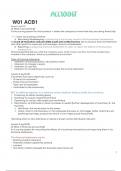Class notes
ACC1006F- Financial Accounting
- Course
- (ACC1006)
- Institution
- University Of Cape Town (UCT)
ALL THE NOTES YOU WILL NEED TO PASS THE EXAM. First-year first-semester financial accounting notes, all weeks start to finish. Notes made from the lecture slides, lecture videos and lecturer talking points thus making them in-depth and comprehensive.
[Show more]



